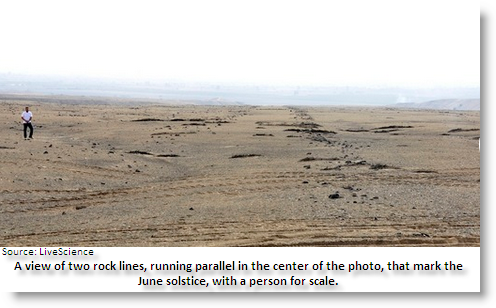 Archaeologists say they have found new rock lines in southern Peru that predate the famous and mysterious Nazca Lines, according to a report on the Live Science website.
Archaeologists say they have found new rock lines in southern Peru that predate the famous and mysterious Nazca Lines, according to a report on the Live Science website.
Archaeologist Charles Stanish, director of the Cotsen Institute of Archaeology at the University of California, Los Angeles, said that the lines were likely used to mark the site of ancient fairs.
Stanish also told Live Science that the lines were likely built by the Paracas civilization around 300 B.C., which would make them at least 300 years older than the giant geoglyphs that were built by the Nazca culture.
“They used the lines in a different way than the Nazca,” Stanish told Live Science. “They basically created these areas of highly ritualized processions and activities that were not settled permanently.”
The 71 geoglyph lines, 353 rock cairns, and a number of ancient mounds were uncovered over three field seasons of work in the Chincha Valley, about 125 miles south of the Peruvian capital of Lima.
 “The lines are effectively a social technology,” Stanish said. “They’re using it for certain purposes. Some people have said the lines point out sacred mountains. Sure, why not? The lines [might] point out sacred pyramids. Why not? The lines could [also] be used to point out processions.”
“The lines are effectively a social technology,” Stanish said. “They’re using it for certain purposes. Some people have said the lines point out sacred mountains. Sure, why not? The lines [might] point out sacred pyramids. Why not? The lines could [also] be used to point out processions.”
Stanish, a member of the American Academy of Arts and Sciences, has worked extensively in southern Peru, northern Chile and Bolivia, and particularly in the Lake Titicaca basin, for over two decades.
The Nazca lines are one of Peru’s most popular attractions. Tourist planes routinely fly over the ancient geoglyphs, which are miles long and depict living creatures like monkeys, llamas, hummingbirds and spiders. The lines remain one of the world’s greatest archaeological enigmas.






(1) Let me begin by pointing out that there is no enigma about the Nazca lines. Professor William Isbell (State University of New York, Binghamton) explained these many years ago as the structural equivalents of pyramid building in other parts of Peru at equivalent periods in sociocultural evolution.
(2) The significance of the contribution by Professor Charles Stanish (UCLA, Cotsen Institute) lies in its explanation of why this specific path (as opposed to pyramid building) was chosen because of local tradition in the Nazca locality. It is timely and welcome.
(3) To understand why any society engages in monumental architecture during the sociocultural stage of Advanced Theocratic Chiefdoms I suggest my own book Karl Marx’s Second Magnum Opus, Archaeology and Primitive Communism, (now available in e-book form at Kindle Books, www. amazon. com for $2.99)